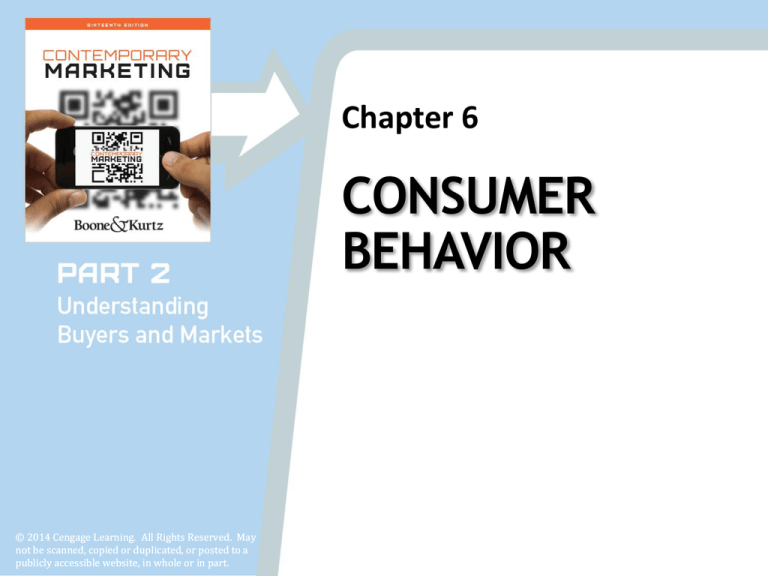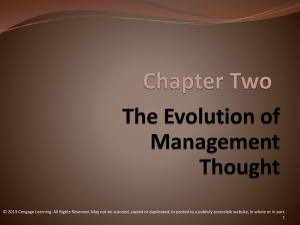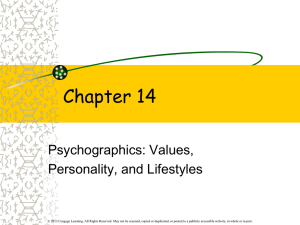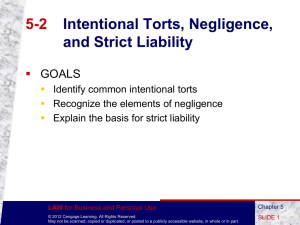
Chapter 6
CONSUMER
BEHAVIOR
© 2014 Cengage Learning. All Rights Reserved. May
not be scanned, copied or duplicated, or posted to a
publicly accessible website, in whole or in part.
1
Chapter 8 Marketing Research
Chapter 6and
Consumer
Sales Forecasting
Behavior
Objectives
1. Define consumer behavior, and describe
the role it plays in marketing decisions.
2. Describe the interpersonal determinants
of consumer behavior: cultural, social,
and family influences.
© 2014 Cengage Learning. All Rights Reserved. May not be scanned, copied or duplicated, or posted to a publicly accessible website, in whole or in part.
2
Chapter 8 Marketing Research
Chapter 6and
Consumer
Sales Forecasting
Behavior
Objectives
3. Explain each of the personal
determinants of consumer behavior:
needs and motives, perceptions, attitudes,
learning, and self-concept theory.
4. Distinguish between high-involvement
and low-involvement purchase decisions.
© 2014 Cengage Learning. All Rights Reserved. May not be scanned, copied or duplicated, or posted to a publicly accessible website, in whole or in part.
3
Chapter 8 Marketing Research
Chapter 6and
Consumer
Sales Forecasting
Behavior
Objectives
5. Outline the steps in the consumer
decision process.
6. Differentiate among routinized response
behavior, limited problem solving, and
extended problem solving by consumers.
© 2014 Cengage Learning. All Rights Reserved. May not be scanned, copied or duplicated, or posted to a publicly accessible website, in whole or in part.
4
Chapter 8 Marketing Research
Chapter 6and
Consumer
Sales Forecasting
Behavior
Consumer Behavior
▮Process through which buyers make
purchase decisions
• Marketers borrow extensively from psychology
and sociology to better understand consumer
behavior
• Consumer behavior is understood as a function
of interpersonal influences and personal
factors
© 2014 Cengage Learning. All Rights Reserved. May not be scanned, copied or duplicated, or posted to a publicly accessible website, in whole or in part.
5
Chapter 8 Marketing Research
Chapter 6and
Consumer
Sales Forecasting
Behavior
Interpersonal Determinants Of Consumer
Behavior
▮Cultural influences
• Culture - Values, beliefs, preferences, and tastes
handed down from one generation to the next
• The broadest environmental determinant of
behavior
© 2014 Cengage Learning. All Rights Reserved. May not be scanned, copied or duplicated, or posted to a publicly accessible website, in whole or in part.
6
Chapter 8 Marketing Research
Chapter 6and
Consumer
Sales Forecasting
Behavior
Core Values in U.S. Culture
▮Work ethic
▮Desire to accumulate wealth
▮Importance of education, individualism,
freedom, youth, health, volunteerism, and
efficiency
▮Consumers are adopting new values
• Communicating with anyone, anytime,
anywhere in the world using new technologies
© 2014 Cengage Learning. All Rights Reserved. May not be scanned, copied or duplicated, or posted to a publicly accessible website, in whole or in part.
7
Chapter 8 Marketing Research
Chapter 6and
Consumer
Sales Forecasting
Behavior
International Perspective on Cultural
Influences
▮Successful strategies in one country may
not extend to other international markets
• Example: Domino’s allows local managers to
run their own advertising campaigns tailored to
the preferences of their customers
© 2014 Cengage Learning. All Rights Reserved. May not be scanned, copied or duplicated, or posted to a publicly accessible website, in whole or in part.
8
Chapter 8 Marketing Research
Chapter 6and
Consumer
Sales Forecasting
Behavior
Subcultures
▮Groups with their own distinct modes of
behavior
• Can differ by ethnicity, nationality, age, rural
versus urban location, religion, and geographic
distribution
▮Population mix in U.S. is changing as the
Hispanic, African American, and Asian
populations grow
© 2014 Cengage Learning. All Rights Reserved. May not be scanned, copied or duplicated, or posted to a publicly accessible website, in whole or in part.
9
Chapter 8 Marketing Research
Chapter 6and
Consumer
Sales Forecasting
Behavior
Figure 6.1 - Ethnic and Racial Minorities as a
Percentage of the Total U.S. Population
© 2014 Cengage Learning. All Rights Reserved. May not be scanned, copied or duplicated, or posted to a publicly accessible website, in whole or in part.
10
Chapter 8 Marketing Research
Chapter 6and
Consumer
Sales Forecasting
Behavior
Subcultures
▮Hispanic American consumers:
• Not a homogenous group
• Hispanic population fueled by a sharp rise in
births
• Marketers should consider Hispanics control
more disposable income than any other
minority group
© 2014 Cengage Learning. All Rights Reserved. May not be scanned, copied or duplicated, or posted to a publicly accessible website, in whole or in part.
11
Chapter 8 Marketing Research
Chapter 6and
Consumer
Sales Forecasting
Behavior
Subcultures
▮African American consumers
• The African American population stands at
more than 40 million people
• Nearly 24 million African Americans are active
Internet visitors, and more than three-fourths
of them visit social media sites
• They are members of every economic group
• Marketers must avoid approaching all African
American consumers in the same way
© 2014 Cengage Learning. All Rights Reserved. May not be scanned, copied or duplicated, or posted to a publicly accessible website, in whole or in part.
12
Chapter 8 Marketing Research
Chapter 6and
Consumer
Sales Forecasting
Behavior
Subcultures
▮Asian American consumers
• Spread among culturally diverse groups
• Retain their own languages
• Each group brings its own language, religion,
and value system to purchasing decisions
© 2014 Cengage Learning. All Rights Reserved. May not be scanned, copied or duplicated, or posted to a publicly accessible website, in whole or in part.
13
Chapter 8 Marketing Research
Chapter 6and
Consumer
Sales Forecasting
Behavior
Social Influences
▮Everyone belongs to multiple social groups
- Family, neighborhood, clubs, and sports
teams
• Group membership influences an individual
consumer’s purchases and behavior in overt
and subtle ways
▮Differences in group status and roles
influence buying behavior
• People make purchases designed to reflect their
status within a particular group
© 2014 Cengage Learning. All Rights Reserved. May not be scanned, copied or duplicated, or posted to a publicly accessible website, in whole or in part.
14
Chapter 8 Marketing Research
Chapter 6and
Consumer
Sales Forecasting
Behavior
The Asch Phenomenon
▮Theory of psychologist S. E. Asch Individuals conform to majority rule, even if
that majority rule goes against their beliefs
▮The Asch phenomenon can be a big factor in
many purchase decisions
• From major choices such as buying a car to
deciding whether to buy a pair of shoes on sale
© 2014 Cengage Learning. All Rights Reserved. May not be scanned, copied or duplicated, or posted to a publicly accessible website, in whole or in part.
15
Chapter 8 Marketing Research
Chapter 6and
Consumer
Sales Forecasting
Behavior
Reference Groups
▮People or institutions such as family,
friends, or celebrities:
• Whose opinions are valued
• To whom a person looks for guidance in his or
her own behavior, values, and conduct
© 2014 Cengage Learning. All Rights Reserved. May not be scanned, copied or duplicated, or posted to a publicly accessible website, in whole or in part.
16
Chapter 8 Marketing Research
Chapter 6and
Consumer
Sales Forecasting
Behavior
Reference Groups
▮Influence of reference group depends on
two conditions:
• The purchased product must be one that others
can see and identify
• The purchased item must be a brand or product
that not everyone owns
© 2014 Cengage Learning. All Rights Reserved. May not be scanned, copied or duplicated, or posted to a publicly accessible website, in whole or in part.
17
Chapter 8 Marketing Research
Chapter 6and
Consumer
Sales Forecasting
Behavior
Social Classes
▮Six classes within the social structures of
both small and large U.S. cities
•
•
•
•
•
•
Upper-upper
Lower-upper
Upper-middle
Lower-middle
Working class
Lower class
© 2014 Cengage Learning. All Rights Reserved. May not be scanned, copied or duplicated, or posted to a publicly accessible website, in whole or in part.
18
Chapter 8 Marketing Research
Chapter 6and
Consumer
Sales Forecasting
Behavior
Social Classes
▮Class rankings determined by occupation,
income, education, family background, and
residence location
• Income is not always a primary factor
▮Occupations and incomes of one or both
parents are primary influences on social
class
▮Individuals’ buying habits reflect the class
to which they aspire
© 2014 Cengage Learning. All Rights Reserved. May not be scanned, copied or duplicated, or posted to a publicly accessible website, in whole or in part.
19
Chapter 8 Marketing Research
Chapter 6and
Consumer
Sales Forecasting
Behavior
Opinion Leaders
▮Trendsetters who purchase new products
before others in a group and then influence
others in their purchases
▮Individuals tend to act as opinion leaders
based on their knowledge of and interest in
products
▮Information about goods and services flows
from mass media to opinion leaders to
consumers
• Sometimes flows directly to consumers
© 2014 Cengage Learning. All Rights Reserved. May not be scanned, copied or duplicated, or posted to a publicly accessible website, in whole or in part.
20
Chapter 8 Marketing Research
Chapter 6and
Consumer
Sales Forecasting
Behavior
Family Influences
▮Family structure has changed over the last
century
• Many couples are separated or divorced, so
single heads of households are more common
▮Role of each spouse in a household:
•
•
•
•
Autonomic role
Husband-dominant role
Wife-dominant role
Syncratic role
© 2014 Cengage Learning. All Rights Reserved. May not be scanned, copied or duplicated, or posted to a publicly accessible website, in whole or in part.
21
Chapter 8 Marketing Research
Chapter 6and
Consumer
Sales Forecasting
Behavior
Children and Teenagers in Family
Purchases
▮Children and teenagers represent a huge
market and they influence what their
parents buy
▮They have significant influence over the
goods and services their families purchase
▮Teens don’t necessarily shy away from
practicality
© 2014 Cengage Learning. All Rights Reserved. May not be scanned, copied or duplicated, or posted to a publicly accessible website, in whole or in part.
22
Chapter 8 Marketing Research
Chapter 6and
Consumer
Sales Forecasting
Behavior
Personal Determinants of Consumer
Behavior
▮Consumer behavior is affected by a number
of internal, personal factors also
• Need - Imbalance between a consumer’s actual
and desired states
• Motive - Inner state that directs a person
toward the goal of satisfying a need
© 2014 Cengage Learning. All Rights Reserved. May not be scanned, copied or duplicated, or posted to a publicly accessible website, in whole or in part.
23
Chapter 8 Marketing Research
Chapter 6and
Consumer
Sales Forecasting
Behavior
Maslow’s Hierarchy of Needs
▮Physiological needs - Needs concerning
essential requirements for survival, such as
food, water, shelter, and clothing
▮Safety needs - Financial or lifestyle security,
protection from physical harm, and
avoidance of the unexpected
▮Social/belongingness needs - The desire to
be accepted by people and groups
important to that individual
© 2014 Cengage Learning. All Rights Reserved. May not be scanned, copied or duplicated, or posted to a publicly accessible website, in whole or in part.
24
Chapter 8 Marketing Research
Chapter 6and
Consumer
Sales Forecasting
Behavior
Maslow’s Hierarchy of Needs
▮Esteem needs - A universal desire for a
sense of accomplishment and achievement
▮Actualization needs - Desire to realize
potential and find fulfillment by expressing
their unique talents and capabilities
© 2014 Cengage Learning. All Rights Reserved. May not be scanned, copied or duplicated, or posted to a publicly accessible website, in whole or in part.
25
Chapter 8 Marketing Research
Chapter 6and
Consumer
Sales Forecasting
Behavior
Table 6.1 - Marketing Strategies Based on
Maslow’s Hierarchy of Needs
© 2014 Cengage Learning. All Rights Reserved. May not be scanned, copied or duplicated, or posted to a publicly accessible website, in whole or in part.
26
Chapter 8 Marketing Research
Chapter 6and
Consumer
Sales Forecasting
Behavior
Perceptions
▮Meaning that a person attributes to
incoming stimuli gathered through the five
senses
▮Results from the interaction of two types of
factors:
• Stimulus factors
• Individual factors
© 2014 Cengage Learning. All Rights Reserved. May not be scanned, copied or duplicated, or posted to a publicly accessible website, in whole or in part.
27
Chapter 8 Marketing Research
Chapter 6and
Consumer
Sales Forecasting
Behavior
Perceptual Screens
▮The mental filtering processes through
which all inputs must pass
▮Techniques that marketers use to elicit a
positive response from consumers:
• Doubling the size of an ad
• Using certain colors or graphics
• Developing unique packaging
▮Word of mouth - The oldest and most
effective marketing technique in existence
© 2014 Cengage Learning. All Rights Reserved. May not be scanned, copied or duplicated, or posted to a publicly accessible website, in whole or in part.
28
Chapter 8 Marketing Research
Chapter 6and
Consumer
Sales Forecasting
Behavior
Subliminal Perception
▮Subconscious receipt of incoming
information
• Aimed at the subconscious level of awareness to
circumvent the audience’s perceptual screens
▮Unlikely to induce purchasing except by
people already inclined to buy
© 2014 Cengage Learning. All Rights Reserved. May not be scanned, copied or duplicated, or posted to a publicly accessible website, in whole or in part.
29
Chapter 8 Marketing Research
Chapter 6and
Consumer
Sales Forecasting
Behavior
Attitudes
▮Person’s enduring favorable or unfavorable
evaluations, emotions, or action tendencies
toward some object or idea
▮Attitude components:
• Cognitive
• Affective
• Behavioral
© 2014 Cengage Learning. All Rights Reserved. May not be scanned, copied or duplicated, or posted to a publicly accessible website, in whole or in part.
30
Chapter 8 Marketing Research
Chapter 6and
Consumer
Sales Forecasting
Behavior
Changing Consumer Attitudes
▮Marketers have two choices for appealing to
consumer attitudes:
• Attempt to produce consumer attitudes that
will lead to the purchase of an existing product
• Evaluate existing consumer attitudes and create
or modify products to appeal to these attitudes
© 2014 Cengage Learning. All Rights Reserved. May not be scanned, copied or duplicated, or posted to a publicly accessible website, in whole or in part.
31
Chapter 8 Marketing Research
Chapter 6and
Consumer
Sales Forecasting
Behavior
Modifying the Components of Attitude
▮Providing evidence of product benefits and
correcting misconceptions
▮Engaging buyers in new behavior
▮New technologies can also encourage
consumers to change their attitudes
© 2014 Cengage Learning. All Rights Reserved. May not be scanned, copied or duplicated, or posted to a publicly accessible website, in whole or in part.
32
Chapter 8 Marketing Research
Chapter 6and
Consumer
Sales Forecasting
Behavior
Learning
▮Knowledge or skill acquired as a result of
experience, which changes consumer
behavior
© 2014 Cengage Learning. All Rights Reserved. May not be scanned, copied or duplicated, or posted to a publicly accessible website, in whole or in part.
33
Chapter 8 Marketing Research
Chapter 6and
Consumer
Sales Forecasting
Behavior
Learning
▮Components of learning process:
• Drive - Fear, pride, greed, jealousy, hunger,
thirst, comfort, and rivalry
• Cue - An object or signal in the environment
that determines the nature of the consumer’s
response to a drive
• Response - Individual’s reaction to a set of cues
and drives
• Reinforcement - Reduction in drive that results
from a proper response
© 2014 Cengage Learning. All Rights Reserved. May not be scanned, copied or duplicated, or posted to a publicly accessible website, in whole or in part.
34
Chapter 8 Marketing Research
Chapter 6and
Consumer
Sales Forecasting
Behavior
Applying Learning Theory to Marketing
Decisions
▮Marketers use shaping
• Applying a series of rewards and
reinforcements, to permit more complex
behavior to evolve
▮Promotional strategy and the product itself
play a role in the shaping process
© 2014 Cengage Learning. All Rights Reserved. May not be scanned, copied or duplicated, or posted to a publicly accessible website, in whole or in part.
35
Chapter 8 Marketing Research
Chapter 6and
Consumer
Sales Forecasting
Behavior
The Shaping Process
▮Offer a free-sample package that includes a
substantial discount for first purchase
▮Entice the consumer to buy the item with
little financial risk
▮Motivate the person to buy the item again at
a moderate cost
▮Customer decides whether to buy the item
at its true price without the discount
coupon
© 2014 Cengage Learning. All Rights Reserved. May not be scanned, copied or duplicated, or posted to a publicly accessible website, in whole or in part.
36
Chapter 8 Marketing Research
Chapter 6and
Consumer
Sales Forecasting
Behavior
Self-Concept Theory
▮Person’s multifaceted picture of himself or
herself
▮Four components that influence purchasing
decisions:
•
•
•
•
Real self
Self-image
Looking-glass self
Ideal self
© 2014 Cengage Learning. All Rights Reserved. May not be scanned, copied or duplicated, or posted to a publicly accessible website, in whole or in part.
37
Chapter 8 Marketing Research
Chapter 6and
Consumer
Sales Forecasting
Behavior
Figure 6.2 - Integrated Model of the
Consumer Decision Process
© 2014 Cengage Learning. All Rights Reserved. May not be scanned, copied or duplicated, or posted to a publicly accessible website, in whole or in part.
38
Chapter 8 Marketing Research
Chapter 6and
Consumer
Sales Forecasting
Behavior
The Consumer Decision Process
▮High-involvement purchase decisions
• Purchases with high levels of potential social or
economic consequences
▮Low-involvement purchase decisions
• Routine purchases that pose little risk to the
consumer
© 2014 Cengage Learning. All Rights Reserved. May not be scanned, copied or duplicated, or posted to a publicly accessible website, in whole or in part.
39
Chapter 8 Marketing Research
Chapter 6and
Consumer
Sales Forecasting
Behavior
Steps in the Consumer Decision Process
▮Consumer becomes aware of a gap between
the existing situation and a desired situation
▮Consumer gathers information about the
attainment of a desired state of affairs
• Evoked set - Number of alternatives that a
consumer actually considers in making a
purchase decision
© 2014 Cengage Learning. All Rights Reserved. May not be scanned, copied or duplicated, or posted to a publicly accessible website, in whole or in part.
40
Chapter 8 Marketing Research
Chapter 6and
Consumer
Sales Forecasting
Behavior
Steps in the Consumer Decision Process
▮Consumer evaluates the evoked set of
options and as the search progresses, the
consumer accepts, distorts, or rejects
• Evaluative criteria - Features that a consumer
considers in choosing among alternatives
▮The consumer narrows the alternatives
down to one
▮The consumer decides where or from
whom to make the purchase
© 2014 Cengage Learning. All Rights Reserved. May not be scanned, copied or duplicated, or posted to a publicly accessible website, in whole or in part.
41
Chapter 8 Marketing Research
Chapter 6and
Consumer
Sales Forecasting
Behavior
Steps in the Consumer Decision Process
▮Post-purchase evaluation – Buyer feels
either:
• Satisfaction at the removal of the discrepancy
between the existing and desired states
• Dissatisfaction with the purchase
▮Cognitive dissonance - Imbalance among
knowledge, beliefs, and attitudes that occurs
after an action or decision, such as a
purchase
© 2014 Cengage Learning. All Rights Reserved. May not be scanned, copied or duplicated, or posted to a publicly accessible website, in whole or in part.
42
Chapter 8 Marketing Research
Chapter 6and
Consumer
Sales Forecasting
Behavior
Steps in the Consumer Decision Process
• Dissonance is likely to increase:
• As the dollar value of a purchase increases
• When the rejected alternatives have desirable
features that the chosen alternatives do not provide
• When the purchase decision has a major effect on
the buyer
▮Marketers can reduce cognitive dissonance
by providing information that supports the
chosen item
© 2014 Cengage Learning. All Rights Reserved. May not be scanned, copied or duplicated, or posted to a publicly accessible website, in whole or in part.
43
Chapter 8 Marketing Research
Chapter 6and
Consumer
Sales Forecasting
Behavior
Classifying Consumer Problem-Solving
Processes
▮Routinized response behavior
• Consumer makes many purchases routinely by
choosing a preferred brand or one of a limited
group of acceptable brands
▮Limited problem solving
• Consumer has previously set evaluative criteria
for a particular kind of purchase but then
encounters a new, unknown brand
© 2014 Cengage Learning. All Rights Reserved. May not be scanned, copied or duplicated, or posted to a publicly accessible website, in whole or in part.
44
Chapter 8 Marketing Research
Chapter 6and
Consumer
Sales Forecasting
Behavior
Classifying Consumer Problem-Solving
Processes
▮Extended problem solving
• Results when brands are difficult to categorize
or evaluate
• Typical of high-involvement purchases
© 2014 Cengage Learning. All Rights Reserved. May not be scanned, copied or duplicated, or posted to a publicly accessible website, in whole or in part.
45
Chapter 8 Marketing Research
Chapter 6and
Consumer
Sales Forecasting
Behavior
Strategic Implications of Marketing in the
21st Century
▮Cultural influences play a big role in
marketers’ relationships with consumers
▮Family characteristics are changing
• This forecasts a change in the way family units
make purchasing decisions
© 2014 Cengage Learning. All Rights Reserved. May not be scanned, copied or duplicated, or posted to a publicly accessible website, in whole or in part.
46
Chapter 8 Marketing Research
Chapter 6and
Consumer
Sales Forecasting
Behavior
Strategic Implications of Marketing in the
21st Century
▮Marketers:
• Constantly work toward changing or modifying
components of consumers’ attitudes to gain a
favorable attitude and purchase decision
• Refine their understanding of the consumer
decision process
• Use their knowledge to design effective
marketing strategies
© 2014 Cengage Learning. All Rights Reserved. May not be scanned, copied or duplicated, or posted to a publicly accessible website, in whole or in part.
47
Chapter 8 Marketing Research
Chapter 6and
Consumer
Sales Forecasting
Behavior
Ski Butternut Video
http://www.cengage.com/marketing/book_content/boone_9781133628460
/videos/ch06.html
© 2014 Cengage Learning. All Rights Reserved. May not be scanned, copied or duplicated, or posted to a publicly accessible website, in whole or in part.
48







